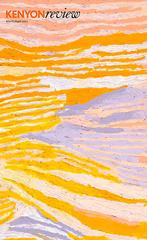A leading literary magazine offers delight, nourishment, and provocation.

In the winter of 1939, Americans were probably thinking about things other than poetry. Spain was crumbling in the face of its civil war; Hitler’s saber-rattling was growing more menacing by the day; and the U.S. economy was just starting to pull out of its nose dive. It was, in other words, a rough time to start a literary magazine.
But poet and critic John Crowe Ransom started the Kenyon Review anyway.
“There is one spot in Paris — it is in the center of a footbridge — that you must visit before the freedom and rest of the City can confer themselves on you,” Ford Madox Ford wrote in that inaugural issue. Take a breath, find refuge, if you can. Let the maelstrom swarm around you.
Since then, the Kenyon Review has evolved into one of the nation’s most prominent literary magazines. Today, readers can find poems, stories, and nonfiction that will surprise, move, or even enrage. Managing Editor Abigail Serfass says she wants readers to be nourished but also challenged by the writing the Kenyon Review publishes.
And publish they do.
The magazine puts out six slim paper journals a year, plus nearly the same amount of content on their online platform, KROnline. (Book-review lovers can find around 100 reviews per year on that site.) Recently, readers have delighted in the stories and poems of Charles Baxter, T.C. Boyle, Joyce Carol Oates, Mary Ruefle, George Saunders, Solmaz Sharif, Safiya Sinclair, and Javier Zamora, among many others.
The Nov/Dec 2016 issue featured the chilling story “When in Bangkok,” which, as Serfass says, drips with menace. “The morning after we landed in Bangkok, my father tossed some baht onto the restaurant table without counting it. Enough eating, he said. My sister and I stood immediately, still chewing,” author Erika Krouse writes. The father hurries off in search of something, pulling his daughters and wife in his terrible wake. The reader follows eagerly, too, wanting to learn how these three women live with a man soon revealed as a monster.
If that center of the Parisian footbridge is a must-see spot, the Kenyon Review seems to argue that art gives us a necessary fulcrum before the world can confer itself upon us. Whether readers fall in love with the exultant poem “X” in the print edition, an online story about a wife who wants to get lost in Rome, or a podcast about art and political engagement, there is much wisdom and delight to be had in the Kenyon Review’s world.
Carrie Callaghan is a senior editor at the Washington Independent Review of Books. Her fiction has appeared in Silk Road, Floodwall, the MacGuffin, the Mulberry Fork Review, and elsewhere. She lives in Maryland with her family and two cats. Find her on the Internet on Twitter at @carriecallaghan or at www.carriecallaghan.com.

